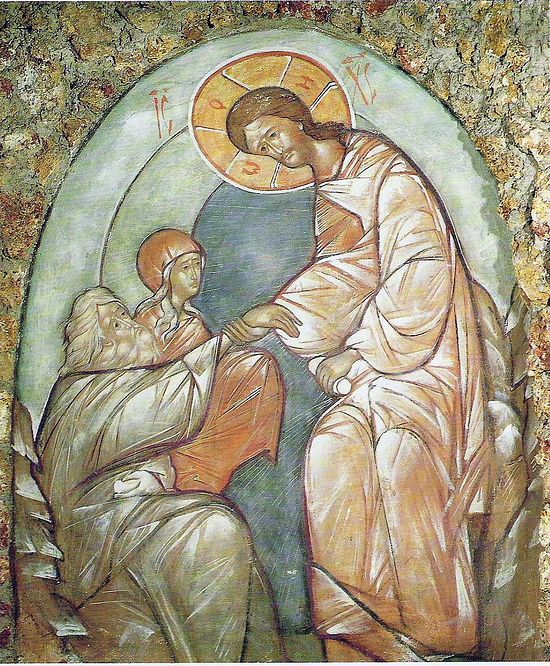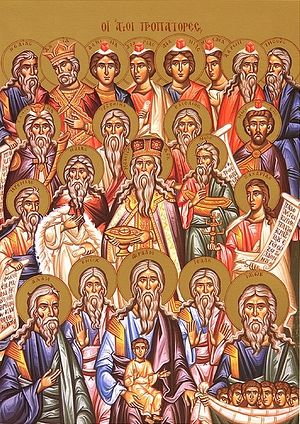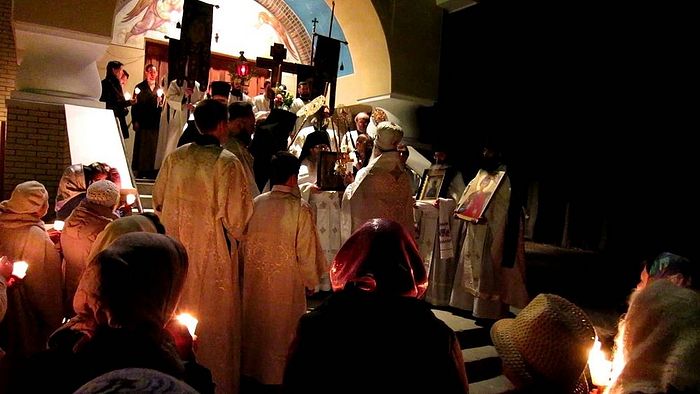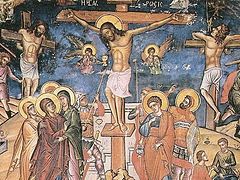Christ is Risen!
Already several festive and wonderful hours of the greatest of feasts have passed. It comes to mind to ask: "Do we sufficiently understand the first minutes of this feast?—Let us return from this radiant day to the day just past, to the night, at first dark, but later as bright as day, and let us consider what has transpired.
At midnight the Church hastened to gather us for the beginning of the feast. Why is this? Because it was desirous that the beginning of the feast would coincide, as much as possible, with the time of that which was being celebrated, i. e., the Resurrection of Christ. The exact time of this has not been revealed to us. When the Myhrrbearing Women arrived at the tomb of the Lord at dawn, it was already opened, and the Angels announced the Resurrection of Christ which had already taken place. Much earlier the earth around the tomb of the Lord had shaken, an Angel had rolled the stone away from the tomb and with his bright appearance had frightened away the guard, thereby giving the Myhrrbearing Women and the Apostles free access to the tomb. The resurrection itself took place earlier, since it occurred while the tomb was still sealed, according to the witness of the Holy Church, the guardian of the mysteries of Christ. It was not before midnight, however, since, according to the words of the Lord, He was to be three days in the tomb; and therefore it must have occurred in the first hours after midnight on the day after the Sabbath. By having the beginning of our feast during these hours we hope to thereby envelop that immeasurably exalted and wondrous minute of the Resurrection, so that the feast, as much as possible, might become one with the celebrated event, just as those who are celebrating are called to be one with the Creator of the feast.
Just before beginning the celebration of the Resurrection of Christ we sang a hymn to the three-day burial of Christ. Why is this?— First, so that the sequence of the commemorations follow the order of the actual events: since the Resurrection of Christ occurred after the three-day burial of Christ. Secondly, so that the evoking of pious sorrow might prepare us for a more proper and clear understanding and genuine feeling of the Divine joy which would follow.
We began the celebration with a hymn in which we confess that Angels in heaven hymn the Resurrection of Christ; then we asked for the grace to glorify it with a pure heart. At first this hymn was sung in the closed altar, while the rest of the church was still silent. What does this ceremony signify? Here also the sequence of events is evident. The Angels learned of and glorified the Resurrection of Christ before man: for man learned of it from the Angels. The opening of heaven was not visible on earth, when Christ opened it invisibly through the power of His Cross, along with His Resurrection, and led the Patriarchs, the Prophets and the Saints of the Old Testament into it, accompanied by the doxology of Angels. We know about this triumphant procession of the heavenly Church through faith, not through seeing it; and so that our knowledge of it will not be too clouded, and our imitation of it in the earthly Church too lifeless, we need to implore Christ our God for grace and a pure heart, because the pure in heart will see God (Matt. 5:8). Having beseeched the Risen Christ Himself for help so that we could worthily glorify Him, we began to glorify Him with a most unusual ceremony. Leaving the altar and the church, we gathered in the dark, at the west side of the church, before the closed doors; and there we exclaimed the first doxology to the Most-Holy Trinity and the Risen Christ. The censer and the cross opened to us the doors of the church, and then from the outer darkness we entered into its inner light and without restraint entered into the joy of the feast. There are such peculiarities here that one should note their incongruity, as well as assume a hidden and profound significance. And what significance?— That which we, in part, already indicated. In the visible actions of the earthly Church are imprinted, as much as possible, an image of the celebration of the heavenly Church.
It is an ancient and sublime law of the Divine Services of the Church that they represent images of the Heavenly. Thus, the Holy Apostle Paul writes concerning the Old Testament priests, that they serve unto the example and shadow of heavenly things (Heb. 8:5). The Christian Church is nearer the Heavenly Church than the Old Testament Church. The Old Testament Church presented, for the most part, images of heaven coming down to earth—the incarnation of the Son of God. The Christian Church, after His coming to earth, must rather show how He, according to the expression of the Prophet, hast ascended on high, and leddest captivity captive (Ps. 67:19), or, to express it more clearly, He has taken the captives and servants of Hades and led them forth into freedom and blessedness, and through His suffering on the Cross He has given mankind the right to the Grace-filled gifts of the Holy Spirit.
The Resurrection and ascent of Christ began not from the tomb only, but from Hades: for after His death on the cross, He was, as the Church confesses, "In the grave bodily, in hell with the soul as God ... and He descended even to Hell and destroyed the darkness there." Although the Patriarchs, Prophets, and Righteous of the Old Testament were not plunged into the depths of darkness like the unbelievers and the impious, they still did not escape the shadow of death and did not enjoy the full light. They had the seed of light, i.e., faith in the coming Christ; but only His actual coming to them and the touch of His Divine light could light their lamps with the light of true heavenly life. Their souls, like the wise virgins, were close to the doors of the heavenly bridal chamber, but only the key of David could open these doors. Only the Heavenly Bridegroom, Who had come out of these doors, could enter through them again, bringing with Him the sons of marriage. And so, the Saviour of the world, after He had been crucified and had died in the visible world, descended into the invisible world, even to Hell, and He illumined the souls of the faithful, led them out of the shadow of death, and opened to them the gates of Heaven and Paradise; and again in the visible world, He manifested the light of the Resurrection.
Do you not see now how the invisible Church united with this visible one, and how the one was represented in the other? We stood in the dark of night on the west side of the church before the closed doors, as if standing along with those who dwell in the invisible world before the closed gates of Paradise. In this way the Church wants to show us how it was before the Resurrection of Christ, and how it would be eternally without the Resurrection of Christ. Then the doxology to the Most-Holy Trinity and the Risen Christ, the Cross and the censer opened to us the doors of the church, like the gates of Heaven and Paradise. By these signs the Church said to us: in like manner do the grace of the Most-Holy Trinity, the name and power of the Risen Christ, faith and prayer open to us the gates of Heaven and Paradise. The burning candles in our hands not only represent the light of the Resurrection, but at the same time they remind us of the wise virgins and urge us to be prepared, with the light of faith, the oil of peace, love and mercy, to meet the second, glorious Coming of the Heavenly Bridegroom at midnight, that we may find the gates of His Kingdom opened to us.
These are some of the characteristics of the present Church service. Let us take care, brethren, that we may be faithful to the mystical guidance of our Mother-Church!
While glorifying Christ, Who is Risen for our sake, let us look with a compunctionate heart at Christ, Who was crucified for us, suffered, died, and was buried, lest our joy be forgotten and be made meaningless. Only he who has himself risen in his heart with Christ can have full and permanent joy in the Resurrection of Christ, and have hope for a triumphant resurrection; and only he can have this hope who takes part in the cross, sufferings, and death of Christ, as the Apostle Paul teaches: For if we have become united with Him by the likeness of His death, we shall be also by the likeness of His resurrection (Rom. 6:5). If so be that we suffer with Him, that we may be also glorified with Him (Rom. 8:17). The festal joy that forgets the cross and death of Christ, which call us to crucify the flesh with its passions and lusts, is perilous—with a spiritual beginning having a fleshly end, changing those who celebrated the Resurrection of Christ into those who crucify Him a second time.
Following the Angels, we have entered into the feast of the Resurrection of Christ; we have gathered together along with the Patriarchs, the Prophets, and the Righteous, led into the Church for the feast like into Paradise and Heaven. Think then, what kind of celebration this must be! It must closely resemble the angelic; it must be worthy of communion with the Heavenly Church of Patriarchs, Prophets, and Saints; it must be worthy of Paradise and Heaven. Do not think that this requirement is too great and impossible for our infirmities. He who celebrates with a pure heart, celebrates with the Angels. He who celebrates with love for God and the Risen Christ, and in the spirit of brotherly love for his neighbor, celebrates in communion with the Heavenly Church, since Heaven is nothing other than the kingdom of Divine Love; and if, as the seer of mysteries assures us, he who abides in love, abides in God (I John 4:16), then he abides no lower than Paradise and Heaven. But if it is not very difficult to rise up in order to celebrate in communion with the Angels and the Heavenly Church, then, lamentably, it is also not very difficult to fall away and be far from communion with them ... He who submerges and buries spiritual joy in fleshly enjoyments no longer celebrates with the bodiless Angels. He who is so occupied with the earthly that he forgets the heavenly is no longer near to the Heavenly Church. He who does not strive to guard his celebration from sinful actions is not celebrating in communion with the Saints. He who does not guard and nourish his inner light, and through carelessness allows it to be extinguished, does not have much hope of seeing the open royal doors of the Heavenly Bridal-chamber, although he may see on earth the open royal doors of the altar.
О Christ the Saviour, glorified in Heaven by the Angels and the blessed souls of the saints of mankind! "Grant also us on earth with pure hearts to glorify Thee!" Amen.
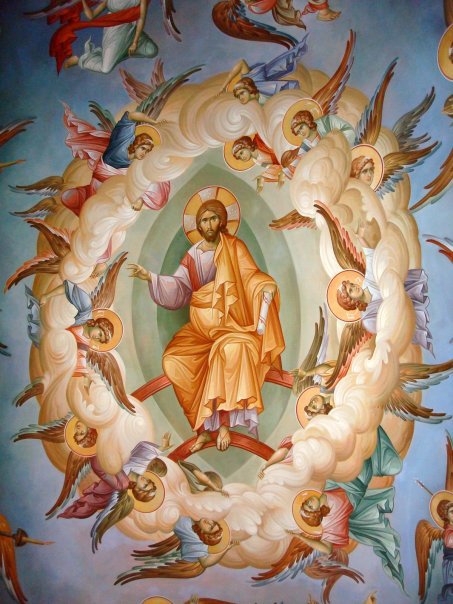
Originally published in Orthodox Life vol. 51, no. 2, Mar-Apr 2001, pp. 2-6.

